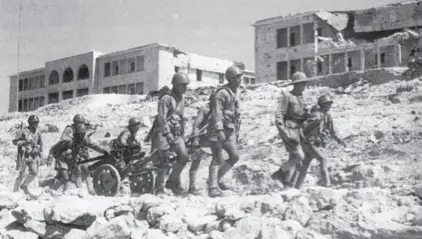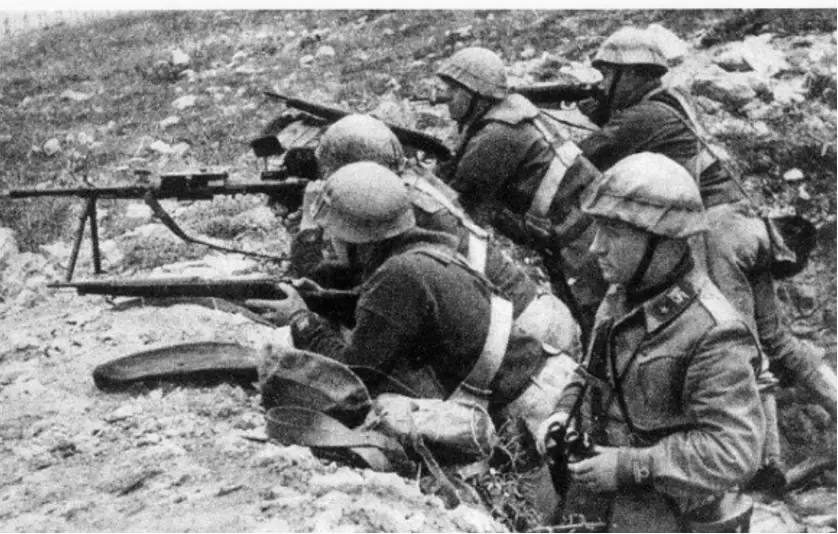Before WW2
The origin of the modern Italian Marine Infantry dates back to the Great War. At the start of the conflict, there was no specific corps or units labelled as Marines. On the contrary, a part of the sailors on board of each naval unit were trained in the use of firearms, and to act as boarding or small landing parties.
During the Great War, the Italian navy (the Regia Marina) was responsible for the defence of Venice, a key naval base, not very far from the frontline. In 1917, the Austro-Hungarian advance was seriously threatening Venice, thus companies of sailors armed with rifles, machine guns and some artillery pieces were rushed to the southern part of the frontline to defend the city. These units, called Brigata Marina, heroically held their ground and earned their reputation. At the end of the conflict, the Brigade became the “San Marco” Battalion, bearing the name of the patron saint of Venice, and adopted the insignia with San Mrk’s lion.
In the interwar period, the battalion was used in garrison duties in Pola, in China (in the Italian concession of Tientsin) and saw active service in the second Italo-Abyssinian war of 1935-1936, and in the occupation of Albania.
In the summer of 1939, the Italian mobilization saw the San Marco growing to a regiment size, with two infantry battalions, “Bafile” and “Grado” forming in 1940.
Early WW2 operations
The first chance to use this special force seemed to arrive during the infamous Italian invasion of Greece in October 1940. The San Marco should have landed on the island of Corfu, securing the islands from the Italian forces. A special naval force, consisting of two WW1 light cruisers, some old torpedo boats, destroyers, plus other auxiliary and transport units would have carried the Italian Marines to their destination. In the end, the Operation against Corfu was cancelled, and the San Marco remained on stand-by until the spring of 1941.
In the same spring of 1941, the Axis forces were building up to launch the final strike against Greece, in this context, Italian military planners planned a daring assault using airborne troops, supported by naval units, to secure the Corinth channel. The airborne troops of the army, back then still training near Rome, were joined by a small detachment of San Marco infantrymen who would have supported the action. The operation never took place, training progressed slowly, and the Germans captured the Corinth canal with their own airborne troops. Anyway, the first group of San Marco Marines trained to drop from the air, constituted the base for a new special branch of the San Marco regiment, the “P” battalion (P standing for paratroopers).
The full-scale Axis invasion of Yugoslavia and Greece, in April 1941, saw the first deployment of the Bafile and Grado Battalions, with the first one deployed in Greece, also performing the landings in Corfu, while the second was deployed in the Adriatic coast of Yugoslavia, garrisoning some key locations, such as Kotor, and later waging some anti-partisan operations.
In North Africa
The theatre where the San Marco saw the most intense use during the war, certainly was North Africa. In November 1941, three companies in total, taken from the Bafile and Grado battalions, arrived in Libya where they constituted the new III Battalion, which by the end of the year amounted to more than 500 men. Initially deployed only for coastal defence, these men participated in the rear guard fights after the successful allied offensive (codename Crusader). The III Battalion remained attached to the Italo-German army and its glory moment came in September 1942.
After the successful second advance into Cyrenaica and the capture of Tobruk, the San Marco was deployed in defence of the city and its surrounding coast. Its HQ and the men assigned to logistics and other services were stationed inside Tobruk while the infantry companies garrisoned the coast, to the west and to the east.

Marines of the San Marco regiment at Tobruk in 1942
On the night of 14 September 1942, a British force of Commandos landed near Tobruk, in the attempt of striking the city airfields and port facilities. They landed a few miles east from their designated zone and incurred in some small detachments of the San Marco who put up stiff resistance. Admiral Giuseppe Lombardi, in command of Tobruk, ordered the counterattacks which were mostly carried out by the HQ and service companies stationed in the city. This, unexpected, and prompted reaction caused the failure of the British operation and the capture of hundreds of prisoners, together with the loss of two destroyers and one light cruiser at sea. After this victory, the III battalion was renamed “Tobruch”.
Still, in September, a small detachment of the San Marco, trained for special operations (N battalion), landed 15 men behind the British lines and sabotaged the railway line between Alexandria and El Alamein. Unable to return to their positions, they were later captured by 8th Army units.
After the battle of El Alamein, the Axis army in Egypt and Cyrenaica retreated to Tripolitania and between January and February 1943 reached the Mareth Line in southern Tunisia. The “Tobruch” battalion followed the remainder of the army, attached to the La Spezia infantry division and fought until the end of the Tunisian campaign.
In the meantime, the Bafile and Grado battalions, who had spent most of 1942 training for the planned (and then cancelled) invasion of Malta, took part in the quick occupation of Corsica and Southern France and by the end of November, they were transferred to Tunisia, operating in the sector of the 5th Panzer Army.
In the first phase of the Tunisian campaign, they served in coastal defence but also helped to repel the allied vanguards coming from Algeria.

Marines of the San Marco regiment fighting in Tunisia
As was the case for other elite special units, like the X Arditi or the Folgore, the San Marco men ended up fighting as elite light infantry, in a hopeless fight against a superior enemy. The Bafile, Grado and Tobruch battalions, or what remained of them, eventually surrendered between the 9 and 13 of May 1943, with only a handful of men managing to escape Tunisia on MAS boats.
Epilogue
With the fall of Tunisia, the San Marco regiment had lost most of its fighting force, and now there was only the newly forming Caorle battalion, the special NP battalion (paratroopers and swimmers), a company guarding the Naval Staff HQ and another one in Bordeaux.
With the armistice of September 1943, most of these units disbanded and later rejoined the co-belligerent Regia Marina forces in Southern Italy, taking part in the war of liberation.
Sources
Crociani, P., & Battistelli, P. (2013). Italian Navy & Air Force Elite Units & Special Forces 1940-1945.
Longo, L. E. (1991). I reparti speciali italiani nella seconda guerra mondiale. Mursia.